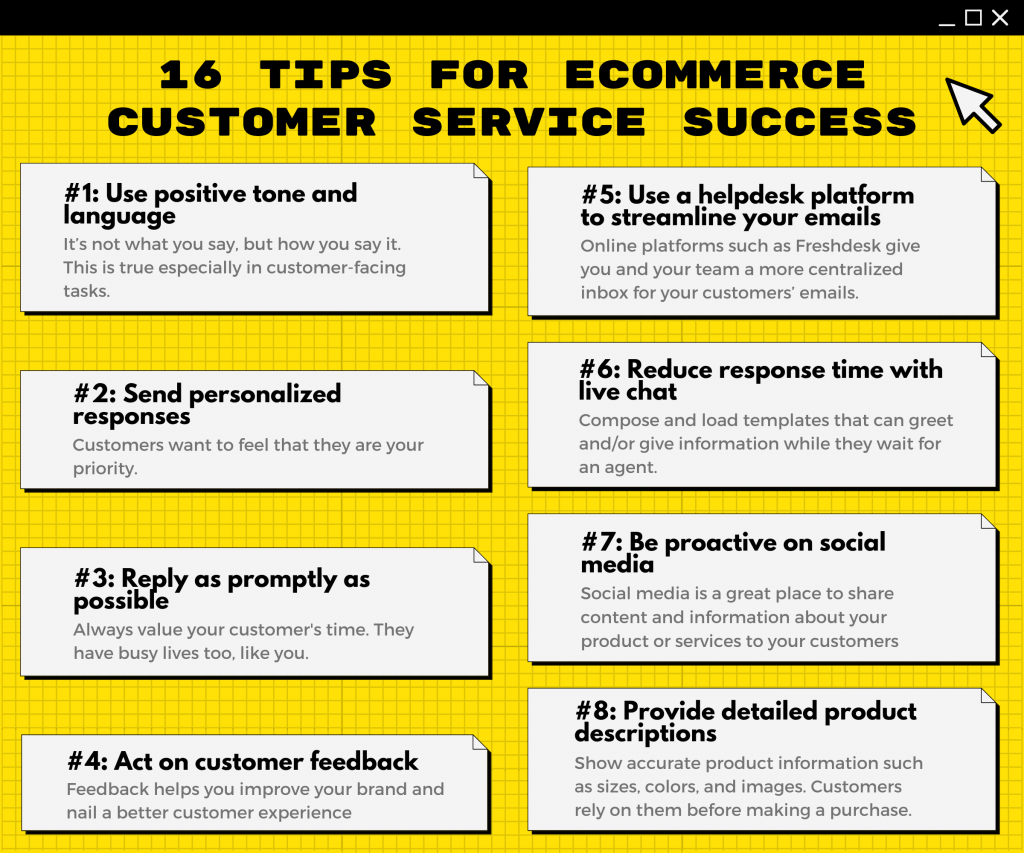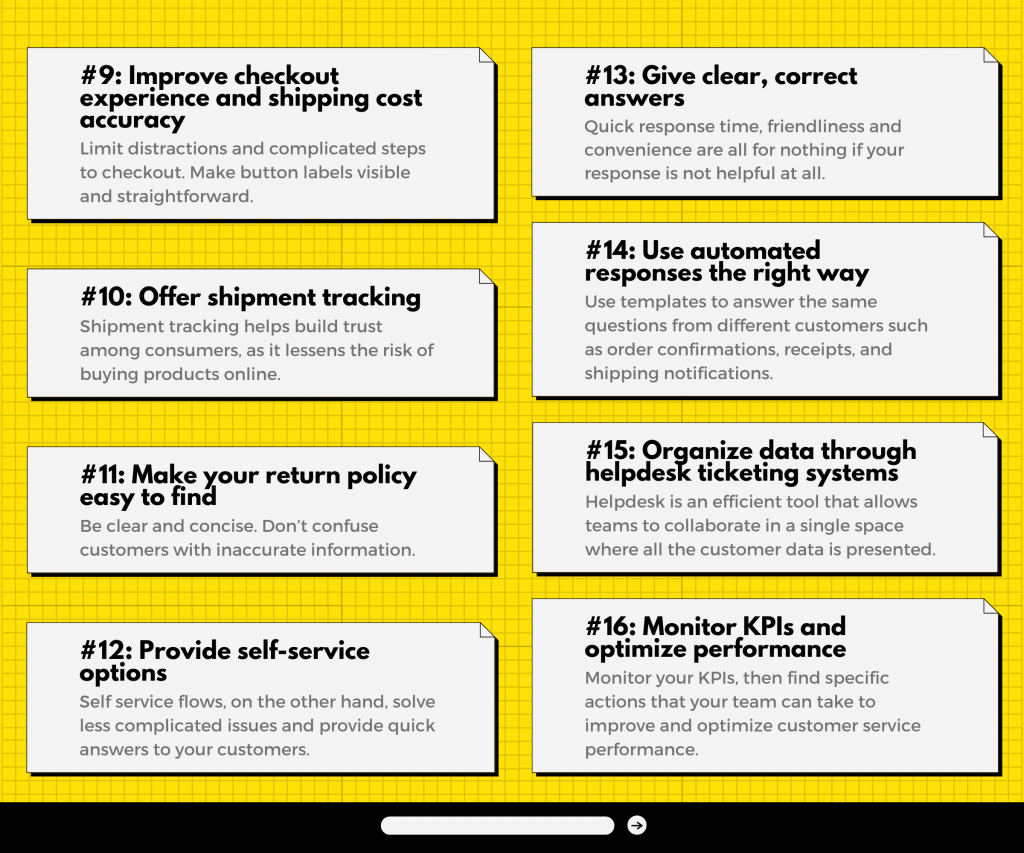
16 Tips for Ecommerce Customer Service Success
CATEGORIES
Tags
24/7 analytics australia automation Business Process Outsourcing company Copywriting CRM customer support data data and analytics Delegate digital digital advertising digital marketing Digital Support Staff ecommerce Email Management Email Marketing Entrepreneur Freelance Writers google ads graphic design Hiring Freelancers Marketing offshore offshoring ominchannel support organizer outsource Outsourcing Philippines Project management reporting seo seo audit Shopify Small Business social media Social media experts social media management United States video Virtual Assistant Virtual Team
Customer service is a crucial part of an eCommerce business, and while 80% of businesses believe they provide good customer service, only one-tenth of customers agree.
According to Gorgias, 95% of consumers agree that brand loyalty and retention are earned through customer service. Moreover, 61% of consumers said that they would leave a brand if it treats a customer poorly– this can serve as a warning that even though customers love your products, they can still leave you after one unpleasant interaction.
On a positive note, 58% of consumers are willing to pay more to be treated with better customer service. Treating customers better helps earn their loyalty, leading to repeat purchases and higher sales.
Here are our top tips for customer service success.
Approach Customers With Finesse
Good customer service requires the right amount of relevance and professionalism. Keep in mind that customers think they are always right, and even if sometimes they are not, you do not want to make them feel bad.
#1: Use a positive tone and language
It’s not what you say, but how you say it. This is true, especially in customer-facing tasks.
Most of the time, sugar-coating bad news helps appease a customer. Whenever they ask for something impossible for you to fix right away, try to offer alternatives. Instead of saying, “The product isn’t available right now,” say, “It will be available next week. How can I contact you by then?”
Maintaining a positive attitude can make customers calm down. Being level-headed and attentive makes them feel that you’re resolving their issue.
Instead of unpleasant facts, set expectations that they can look forward to.
#2: Send personalized responses
Customers want to feel that they are your priority. A personalized response assures them that you paid attention to their inquiries and remembered what they are talking about. Address them by their names and mention things they have said that are relevant to the issue, to prove that you are listening.
You can use your customer data to personalize your responses. Integrating your inventory management, order management, eCommerce platform, and shipping software makes it easier to track specific information of a certain customer.
#3: Reply as promptly as possible
Always value your customers’ time. They have busy lives too, just like you. Do not treat them as if they can wait, because most of them can’t. According to Statista, 12% of Americans answered “lack of speed” as their no. 1 frustration with customer service. The longer you leave it (radio silence), the more their frustration will grow.
Response templates allow you to standardize a response to the most common issues, saving you time starting from scratch every time a customer reaches out. However, you should leave room for personalization when it is needed, so your answers apply directly to the customer’s questions. At the very least, send a short, personalized response letting them know you have received their message and you will get back to them once you have more details.
#4: Act on customer feedback
Customer reviews are there to help improve your brand and to provide a better customer experience. 77% of consumers say that brands are viewed more favorably if they encourage and accept customer feedback. Acting on customer feedback benefits your brand because satisfied customers recommend your brand to others.
The right time to ask for feedback is immediately after a customer service conversation, a purchase, or while, as it gives the natural feeling to ask for it. Meanwhile, negative feedbacks are a good starting point for what to improve. Acting on customer feedback gives a sense of accomplishment to customers that indeed, they are part of the brand.
Be Reachable: Use Multichannel
Customers shouldn’t have to search the entire web to reach your customer service team. Having multiple channels available for customers helps make it easier for them to contact you on whatever platform they prefer: email, live chat, social media, and so on.
#5: Use a helpdesk platform to streamline your emails
Freshdesk, Zendesk, and other platforms give you and your team a more centralized inbox for your customers’ emails.
Gmail doesn’t cut it when you’re dealing with a lot of customer emails. These helpdesk platforms give your entire team visibility and accountability on emails as they come in as tickets. Nothing falls through the cracks.
#6: Reduce response time with live chat
Many consumers prefer live chat, especially now that more Gen Z shoppers are entering the market. Econsultancy reports say 79% of customers prefer live chat as it offers quicker responses compared to other channels.
With live chat, you shouldn’t keep customers waiting, as they are interacting with you in real time and expect an immediate response. Live chat can increase customer satisfaction and sales as they are less likely to leave without purchasing if you have answered their questions clearly and on time.
Compose and load templates that can greet and/or give information while they wait for an agent.
#7: Be proactive on social media
Monitoring social media mentions and answering customers’ complaints is a good way of utilizing social media, but if your customers keep asking about the same things, that’s a clue that you need to provide additional information they can turn to.
Social media is a great place to share content– whether it’s educational content, how-to videos, blog posts, pinned posts, or upcoming events, you can use them to help your customers get the most out of your products/services. These resources can lessen the number of support requests coming in.
Aim for a frictionless shopping experience
Accessible and user-friendly features are good customer service by themselves. Customers expect to have a seamless online store experience. Give them no less and earn their loyalty.
#8: Provide detailed product descriptions
In 2021, 16.6% of all online orders were ultimately returned. Ecommerce stores have always had much higher return rates compared to physical stores, mainly because customers can’t inspect products online.
While there is no way to provide online customers with a physical product experience, a highly-detailed product description is the closest thing.
Provide accurate information on products such as exact sizes, right colors, and vivid images. Customers rely on them before making a purchase.
#9: Improve checkout experience and shipping cost accuracy
The checkout process also determines if a customer proceeds with the purchase or not.
Limit distractions and complicated steps to checkout. Make button labels visible and straightforward.
On the other hand, shipping cost accuracy is one of the factors that consumers are considering before actually buying. Your eCommerce store should provide the exact amount of shipping fees so consumers would not be confused about the total amount they have to pay, and they can use it as a reference for future purchases.
#10: Offer shipment tracking
Almost 70% of consumers say that being able to track their order is one of their priorities when buying online, and 56% said it is their top priority when ordering a luxury item.
Shipment tracking helps build trust among consumers, as it lessens the risk of buying products online. Customers want a higher level of comfort in their purchases, especially on international items.
Also, shipment tracking reduces customer complaints. Without shipment tracking, customers most likely reach out to customer service to inquire about the ETA of their ordered items. Shipment tracking provides them with that exact information, automatically provided to your customers without creating any extra work for you.
#11: Make your return policy easy to find
Ideally, you wouldn’t want customers to return your product, but it’s important to be transparent about your return policy.
68% of customers check the return and exchange policy before making a purchase. Although a return may not make your business profitable, it is important in building customer trust.
Make sure that your consumers can easily find your return policy page or guidelines and all relevant information.
Be clear and concise. Don’t confuse customers, which leads to unnecessary customer queries or worse, withdrawal of purchase.
Utilize Efficient Problem-solving Methods
Customers expect you to answer and solve all of their queries, and you should provide them with all possible solutions, but they also want the answers and solutions accessible to them rather than something they have to ask for.
#12: Provide self-service options
According to Harvard Business Review, 81% of all customers attempt to find answers to their questions first before reaching out to customer support. Most customers want an accurate, complete answer accessible within the eCommerce platform because they don’t want to rely on customer service that could take hours or days to reply.
Knowledge bases such as FAQs, help centers, and self-service flows answer customer queries much faster. They don’t require real-time interaction with the customer service team.
Your FAQ page should be easy to find and contains both basic information and complex ones. Provide straightforward, organized, and easy-to-follow answers. Every six months, look back on customer queries and reflect on trends. Add more items to your FAQ page as you discover new problems filling up the queries.
Self-service flows, on the other hand, solve less complicated issues and provide quick answers to your customers. It comes with easy-to-navigate menus while still making it clear they are not yet connected to a customer service rep.
#13: Give clear, correct answers
Resolving an issue is what customer service is for. Quick response time, friendliness, and convenience are all for nothing if your response is not helpful at all. Customers are only satisfied with your service if you can solve their problems. Remember that customer service is responsible for providing solutions more than anything else.
#14: Use automated responses the right way
Use templates to answer the same questions from different customers such as order confirmations, receipts, and shipping notifications. Automated template responses save time. Automation helps customer service representatives to focus on more important tasks, but it should be done the right way at the right time.
You can use automation without losing your personal touch. Customers send very specific questions and giving them an automated response that does not address their question makes it look like you’re not paying attention to their request.
Set up a personalized auto-reply that is human-like. Address them by their name, and set a message that sounds natural, all while still being honest that it’s an automatic reply. However, you should assess the issue and determine whether you can resolve it with a personalized auto-reply, or if it requires a live customer service agent.
#15: Organize data through helpdesk ticketing systems
Helpdesk is commonly known as a place where customers find answers to their questions. In the eCommerce world, customer service teams use helpdesk software to manage and organize customer “tickets”.
Helpdesk is an efficient tool that allows teams to collaborate in a single, unified space where all customer data is stored and displayed. With a helpdesk, you can incorporate email, live chat, and social media into one platform.
Some key features of the helpdesk include knowledge base, automation, tags, agent reports, and a universal inbox. As an eCommerce business grows and caters to all channels, customer service representatives won’t waste time switching between apps or separately looking for customers’ data.
There is a lot of helpdesk software available– choose one that suits your team the most.
#16: Monitor KPIs and optimize performance
To monitor your KPIs properly, they should be clear and measurable. Your customer service team needs to monitor KPIs to assess how their performance affects the brand.
Tracking KPIs and customer service metrics helps you understand their impact on your revenue and helps you measure the quality of your customer experience.
According to Gorgias’ research, repeat customers generate 300% more revenue than first-time customers of eCommerce brands. Customer retention greatly affects revenue.
Meanwhile, customer experience is not easy to measure, but evaluating it helps you identify what’s working and what’s not.
After monitoring your KPIs, find specific actions that your team can take to improve and optimize customer service performance. Provide additional training, staffing, and tools if needed.
Good customer service for eCommerce success
Good customer service guarantees eCommerce success, especially now in a saturated market with a more discerning consumer base.
They want a seamless shopping experience with friendly and approachable customer service agents that are reachable across multiple channels, providing solutions to their problems.
Ensuring you have a well-equipped customer service team is the key to eCommerce success. A happy customer is a loyal customer.



